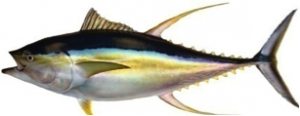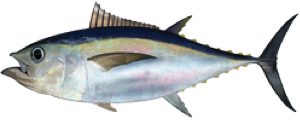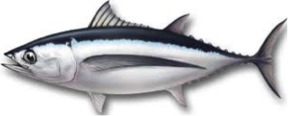Our Products
Yellowfin Tuna

The Yellowfin Tuna, Thunnus Albacores is a type of tuna found in open waters of tropical and subtropical seas worldwide. Reported sizes have ranged as high as 239cm (94 inches) in length and 200kg (440lb) in weight. Yellow fin is becoming a popular replacement for the severely depleted supplies of blue fin tuna in the sushi markets.
As its common name suggests, the second dorsal fin and the anal fin are both bright yellow and can be very long in mature specimens, as are the pectoral fins.
We export our Yellowfin Tuna fresh and frozen in Whole Round (WR), Gill & Gutted (GG), Headed Gutted & Tailed (HGT) and Loins.
Download Our Technical Specification for Yellow Fin here:
Bigeye Tuna

The Bigeye tuna, Thunnus Obesus, is a true tuna of the genus Thunnus, belonging to the wider mackerel family Scombridae. Bigeye tuna are found in the open waters of all tropical and temperate oceans.
Bigeye tuna vary up to 250 centimeters (98 in) in length. Its maximum weight probably exceeds 400 pounds (180 kg), with the all-tackle angling record standing at 392 pounds (178 kg).
They are large, deep-bodied, streamlined fish with large heads and eyes. The pectoral fins are very long, reaching back as far as the second dorsal. They display 13 or 14 dorsal spines.
The Bigeye forages in cold and oxygen-poor subsurface waters. Their blood extracts oxygen efficiently even in oxygen-poor conditions. Their vision functions well in low light conditions. The heart has an unusual ability to function effectively while foraging in cold subsurface water.
Longer-lived than the closely related yellow fin tuna, the Bigeye has a lifespan of up to 12 years, with sexual maturity at age four. Spawning takes place in June and July in the northwestern tropical Atlantic, and in January and February in the Gulf of Guinea, which is the only known Atlantic nursery area.
We export our Bigeye Tuna fresh and frozen in Whole Round (WR), Gill & Gutted (GG), Headed Gutted & Tailed (HGT) and Loins.
Download Our Technical Specification for Bigeye Tuna here:
Albacore Tuna
 The Albacore Tuna, Thunnus Alalunga, is also called albacore fish, longfin tuna, albies, pigfish, tombo ahi, binnaga, Pacific albacore, German bonito, longfin tunny or even just tuna. It is the only tuna species which may be marketed as “white meat tuna” in the United States.
The Albacore Tuna, Thunnus Alalunga, is also called albacore fish, longfin tuna, albies, pigfish, tombo ahi, binnaga, Pacific albacore, German bonito, longfin tunny or even just tuna. It is the only tuna species which may be marketed as “white meat tuna” in the United States.
It is found in the open waters of all tropical and temperate oceans and the Mediterranean Sea and the South East Atlantic. The average size grading that we can offer from South Africa and Namibia are as follows: 3-7kgs, 7-10kgs and 10kgs+.
Albacore is a prized food and the albacore fishery is economically significant. The catching method that our suppliers utilize is Pole and Line, the most scientifically proven sustainable way to target this species for wild capture.
The pectoral fins of the albacore are very long, as much as 50% of the total length. The dorsal spines are 8 to 10 in number, and well forward of the rays of the dorsal fin. The anterior spines are much longer, giving a concave outline to the spiny part of the dorsal fin.
We export Albacore Tuna fresh and frozen in Whole Round (WR) Form.
Download Our Technical Specification for Albacore Tuna here:
Hake

The deep-water Cape hake (Merluccius paradoxus) is a merluccid hake of the genus Merluccius similar to cod and haddock, found in the south-eastern Atlantic Ocean, along the coast of Southern Africa. Its range extends in decreasing abundance around the southern coast of Africa and into the Indian Ocean, but it is at its most plentiful in the cold, nutrient-rich fishing grounds of the Benguela Current.
In South Africa, in combination with Merluccius capensis, the shallow-water Cape hake, it is one of the most important commercial food fishes and locally is generally known as “stockfish” (this English name being derived from the Afrikaans stokvis).
Very similar to M. merluccius (European hake), it has an average length of 40–60 cm, up to a maximum of about 80 cm. It lives close to the bottom in muddy areas on the continental shelf and slope. It usually is to be found at depths of 200 to 850m, although most commonly below 400m. Mature hake feed mainly on fish, squid, and crustaceans. The fish stay in deep sea water during the day and come to shallower depths during the night. An undiscerning predator, hake feed on their prey found near or on the bottom of the sea.
We export our Hake fresh and frozen in Whole Round (WR) and Headed & Gutted (H&G) and Fillets.
Download Our Technical Specification for Hake here:
Yellow Tail

Yellow Tail (Seriola lalandi) is also known by several alternate names, such as amberjack, forktail, mossback, and white salmon or by its Spanish name jurel. Yellow Tail is caught in the Atlantic and Indian Oceans long the South African Coastline from near shore to offshore often congregating around floating kelp and sea mounts.
This fish prefers the warmer water temperature between 18 -22° Celsius and have been known to swim to deeper depths in colder waters to conserve energy. A highly prized fish by sport fisherman, this is arguably the 4th most consumed fish in the sushi market where it is better known has “Hamachi.”
Our Yellow Tail is shipped fresh and frozen in Whole Round (WR) form only.
Download Our Technical Specification for Yellow Tail here:
Snoek

Snoek (Thyrsites Atun) is a long, thin, species of snake mackerel found in the seas of the Southern Hemisphere. It is very important to commercial fisheries and is also a popular game fish. It is found near continental shelves or around islands and feeds on crustaceans, cephalopods and small fish such as anchovy and pilchard. This species will form schools near the bottom or midwater; sometimes even near the surface at night. It prefers sea water temperature between 13 and 18 °C (55 and 64 °F).
Its appearance is bluish-black on top with a silver belly and the snoek grows to over a metre in length. Our Snoek is caught by artisanal fishermen utilizing the handline fishing method which is has little or no impact on the environment. Snoek is oily, extremely bony (although the bones are large and easily removed from the cooked fish) and has very fine scales which are almost undetectable. Snoek has a very distinctive taste and is very popular in regions of South Africa.
Snoek is sold both fresh and frozen either whole round or mild cured with salt.
Baracouta

Baracouta is a ray-finned fish known for its large size and fearsome appearance. Its body is long, fairly compressed, and covered with small, smooth scales. Some species can reach up to 2.1 m (6.9 ft) in length and 30 cm (12 in) in width. The Baracouta is a saltwater fish of the genus Sphyraena, the only genus in the family Sphyraenidae, and is found in tropical and subtropical oceans worldwide ranging from the Eastern border of the Atlantic Ocean to the Red Sea and Caribbean Sea.
In most cases the Baracouta is dark blue, dark green, white, or grey on its upper body, with silvery sides and a chalky-white belly.
Our Baracouta is imported from New Zealand and is offered as either pocket gutted or mild cured with salt.
